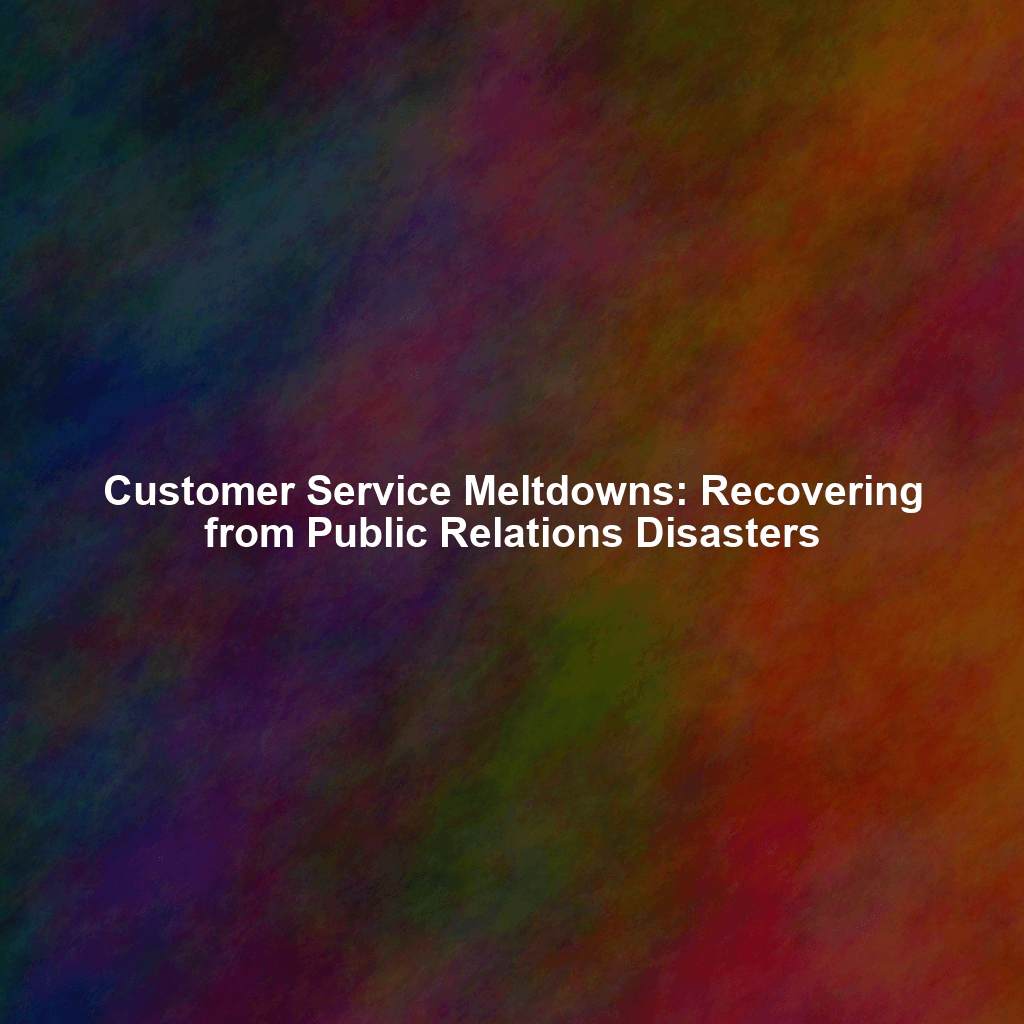Introduction: When “The Customer is Always Right” Goes Horribly Wrong
Understanding the Anatomy of a Customer Service PR Disaster
The Trigger: A Single Point of Failure
Customer service meltdowns often begin with a single point of failure: a mishandled request, a rude employee, a system glitch, or a policy perceived as unfair. This initial incident, while seemingly minor, can quickly escalate if not addressed promptly and effectively. Consider the case of United Airlines, where a passenger was forcibly removed from an overbooked flight. The initial incident, coupled with the company’s initial tone-deaf response, sparked a global uproar and significant damage to their brand reputation. The key takeaway here is that even seemingly isolated incidents can have far-reaching consequences.
The Amplification Effect: Social Media’s Role
Social media acts as a powerful amplifier, magnifying both positive and negative experiences. A disgruntled customer can instantly share their grievances with thousands, or even millions, of people. A poorly handled response on social media can further fuel the fire, turning a localized problem into a global crisis. Conversely, a swift and sincere apology, coupled with demonstrable action to rectify the situation, can help to mitigate the damage and even turn a negative situation into a positive opportunity to showcase a company’s commitment to customer satisfaction.
The Contagion: Reputational Damage and Financial Impact
The consequences of a customer service PR disaster can be severe. Reputational damage is perhaps the most immediate and visible impact. Negative reviews, social media backlash, and media coverage can erode consumer trust and loyalty. This, in turn, can lead to a decline in sales, lost revenue, and a decrease in stock value (for publicly traded companies). Moreover, rebuilding a damaged reputation can be a long and expensive process, requiring significant investment in public relations and customer service initiatives.
Common Causes of Customer Service PR Disasters
Lack of Employee Training and Empowerment
One of the most frequent causes of customer service failures is inadequate employee training. When employees are not properly equipped to handle difficult situations or are not empowered to make decisions that benefit the customer, they are more likely to escalate problems. Proper training should encompass product knowledge, communication skills, conflict resolution techniques, and a thorough understanding of company policies and procedures. Furthermore, empowering employees to take ownership of customer issues and find creative solutions can prevent minor problems from snowballing into major crises.
Poor Communication and Lack of Transparency
A lack of clear and transparent communication is another common culprit. When customers feel ignored, dismissed, or misled, their frustration can quickly escalate. Companies should strive to provide timely and accurate information, even when the news is not good. Honesty and transparency are crucial for building trust and demonstrating a commitment to resolving the issue. Avoiding communication or providing vague or misleading information only serves to exacerbate the problem and further damage the company’s reputation.
Inflexible Policies and Procedures
Overly rigid policies and procedures can also contribute to customer service meltdowns. While it’s important to have guidelines in place, companies should also allow for flexibility and discretion in exceptional circumstances. Blindly adhering to policies without considering the individual circumstances of each case can lead to unfair outcomes and frustrated customers. Empowering employees to make exceptions and find creative solutions that address the customer’s specific needs can often prevent a minor inconvenience from turning into a major PR crisis.
Ignoring Customer Feedback
Failing to actively listen to and address customer feedback is a recipe for disaster. Customer feedback, whether positive or negative, provides valuable insights into areas where a company can improve its products, services, and customer experience. Ignoring this feedback sends a message that the company doesn’t care about its customers’ opinions, which can lead to resentment and negative word-of-mouth. Actively soliciting and responding to customer feedback demonstrates a commitment to continuous improvement and a genuine desire to meet customer needs.
Strategies for Recovering from a Customer Service PR Disaster
Acknowledge and Apologize Quickly and Sincerely
The first step in recovering from a customer service PR disaster is to acknowledge the problem and apologize sincerely. A timely and heartfelt apology demonstrates that the company takes responsibility for its actions and is genuinely sorry for the inconvenience or harm caused. Avoid making excuses or blaming others. Instead, focus on expressing empathy and acknowledging the customer’s feelings. A sincere apology can go a long way in diffusing anger and rebuilding trust.
Take Ownership and Take Responsibility
Beyond apologizing, it’s crucial to take ownership of the problem and take responsibility for finding a solution. This means acknowledging the company’s role in the incident and demonstrating a willingness to make things right. Avoid shifting blame or making excuses. Instead, focus on identifying the root cause of the problem and implementing measures to prevent it from happening again. Taking ownership and responsibility demonstrates a commitment to accountability and a genuine desire to learn from mistakes.
Communicate Clearly and Transparently
Throughout the recovery process, it’s essential to communicate clearly and transparently with customers, employees, and the public. Provide regular updates on the progress of the investigation and the steps being taken to resolve the issue. Be honest and upfront about the challenges and obstacles encountered. Transparency builds trust and demonstrates a commitment to keeping stakeholders informed. Use multiple channels of communication, including social media, email, and traditional media, to reach all affected parties.
Offer a Meaningful Resolution
In addition to apologizing and taking responsibility, it’s crucial to offer a meaningful resolution to the affected customer(s). This could involve a refund, a replacement product, a discount on future purchases, or some other form of compensation that is proportionate to the harm caused. The resolution should be tailored to the specific circumstances of the case and should demonstrate a genuine effort to make things right. A generous and thoughtful resolution can help to repair the relationship with the affected customer(s) and demonstrate a commitment to customer satisfaction.
Learn from the Experience and Implement Preventative Measures
Finally, it’s essential to learn from the experience and implement preventative measures to avoid similar problems in the future. Conduct a thorough review of the incident to identify the root causes and contributing factors. Implement changes to policies, procedures, and employee training programs to address these issues. Regularly monitor customer feedback and social media channels to identify potential problems early on. By learning from past mistakes and implementing proactive measures, companies can reduce the risk of future customer service PR disasters.
Turning a Crisis into an Opportunity
While customer service PR disasters can be damaging, they also present an opportunity for growth and improvement. By responding quickly, sincerely, and effectively, companies can demonstrate their commitment to customer satisfaction and rebuild trust with their customers. Moreover, by learning from their mistakes and implementing preventative measures, they can create a more customer-centric culture and improve their overall business performance. Ultimately, how a company responds to a crisis can define its brand and shape its future.
Conclusion: The Road to Redemption
Customer service meltdowns are an unfortunate reality in today’s interconnected world. However, they don’t have to be fatal. By understanding the causes, consequences, and strategies for recovery, companies can navigate these challenges effectively and emerge stronger than before. Remember, a sincere apology, a commitment to transparency, and a genuine desire to make things right can go a long way in rebuilding trust and repairing a damaged reputation. Turning a customer service PR disaster into a positive learning experience is not just about damage control; it’s about building a more resilient and customer-focused organization.
 Skip to content
Skip to content

